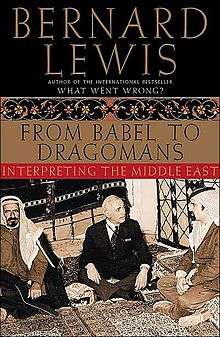From Babel to Dragomans

From Babel to Dragomans: Interpreting the Middle East is a 2004 book written by Middle-East historian Bernard Lewis.
Description
The book comprises a series of scholarly essays and speeches given over the past 4 decades on the topic of the Middle East and the Islamic world.
Quotes from the author
- What is the historian trying to do? First, on the most rudimentary level, to find out what happened. Then, at a rather more sophisticated level, to find out how it happened. And, for the intellectually ambitious, why it happened. This is surely the really interesting part of understanding the past.
- How does one actually set about distorting history? The best and most effective method of course is invention, supported by fabrication. One invents events, and if convenient or necessary one fabricates the evidence to support one’s inventions. A fabrication may be personal and deliberate; it may be collective and unconscious. Both kinds can usually be detected by critical historical scholarship.
- Nowadays it has become fashionable to present the Crusades as an early example of aggressive, predatory Western imperialism against the Muslim East. But how did the previously Christian East become Muslim? If we go back a few centuries we might notice that the Crusade was preceded by the Jihad—that is, a similar invasion moving in the opposite direction—and one might not unreasonably describe the Crusade as a long delayed, limited Christian response to the Muslim Jihad. .
- Slavery is a very disagreeable fact in human history, not just American history. American historians faced this honorably, recognizing the fact, discussing it, documenting it, analyzing it without any attempt to offer excuses. It was not embellished, as it was not long ago at an African History Conference, where one of the most famous African slave traders was described as running “an intercontinental employment agency.” There are societies in which slavery has been a fact of life, in some of them very recently, in some even to the present day. But the subject is taboo. Not long ago a graduate student who wanted to work on slavery in the medieval Middle East was strongly advised, not by any Middle Eastern authority but by a grant-giving body in this country, to choose some “less provocative” subject. To study the history of the Middle East without slavery would be as meaningful as to study the history of the American South or the Roman Empire without slavery. Nevertheless, it is widely done. Many books, indeed I suppose most general books on Middle Eastern history, either don’t mention it or gloss over it, and research in that field is discouraged in a number of ways.
Contents
- Chapter 1 : An Islamic mosque
- Chapter 2 : From Babel to Dragomans (PDF online)
- Chapter 3 : Middle East feasts
- Chapter 4 : Iran in history
- Chapter 5 : Palimpsests of Jewish history : Christian, Muslim and secular diaspora
- Chapter 6 : Some notes on land, money and power in medieval Islam
- Chapter 7 : An interpretation of Fatimid history
- Chapter 8 : Propaganda in the pre-modern Middle East : a preliminary classification
- Chapter 9 : Monarchy in the Middle East
- Chapter 10 : Religion and murder in the Middle East
- Chapter 11 : The Mughals and the Ottomans
- Chapter 12 : Europe and the Turks : the civilization of the Ottoman empire
- Chapter 13 : Europe and Islam : Muslim perceptions and experience
- Chapter 14 : Cold war and detente in the sixteenth century
- Chapter 15 : From pilgrims to tourists : a survey of Middle Eastern travel
- Chapter 16 : The British mandate for Palestine in historical perspective
- Chapter 17 : Pan-Arabism
- Chapter 18 : The emergence of modern Israel
- Chapter 19 : Orientalist notes on the Soviet-United Arab Republic Treaty of 27 May 1971
- Chapter 20 : A taxonomy of group hatred
- Chapter 21 : Islam and the West
- Chapter 22 : The Middle East, westernized despite itself
- Chapter 23 : The Middle East in world affairs
- Chapter 24 : Friends and enemies : reflections after a war
- Chapter 25 : Return to Cairo
- Chapter 26 : Middle East at prayer
- Chapter 27 : At the United Nations
- Chapter 28 : The anti-Zionist resolution
- Chapter 29 : Right and left in Lebanon
- Chapter 30 : The Shi'a
- Chapter 31 : Islamic revolution
- Chapter 32 : The enemies of God
- Chapter 33 : The roots of Muslim rage
- Chapter 34 : The other Middle East problems
- Chapter 35 : Did you say "American imperialism"? : power, weakness, and choices in the Middle East
- Chapter 36 : The law of Islam
- Chapter 37 : Not everybody hates Saddam
- Chapter 38 : Mideast states : pawns no longer in imperial games
- Chapter 39 : What Saddam wrought
- Chapter 40 : The "sick man" of today coughs closer to home
- Chapter 41 : Revisiting the paradox of modern Turkey
- Chapter 42 : We must be clear
- Chapter 43 : Deconstructing Osama and his evil appeal
- Chapter 44 : Targeted by a history of hatred
- Chapter 45 : A time for toppling
- Chapter 46 : In defense of history
- Chapter 47 : First-person narrative in the Middle East
- Chapter 48 : Reflections on Islamic historiography
- Chapter 49 : The Ottoman archives : a source for European history
- Chapter 50 : History writing and national revival in Turkey
- Chapter 51 : On occidentalism and orientalism
This article is issued from Wikipedia - version of the 3/18/2016. The text is available under the Creative Commons Attribution/Share Alike but additional terms may apply for the media files.